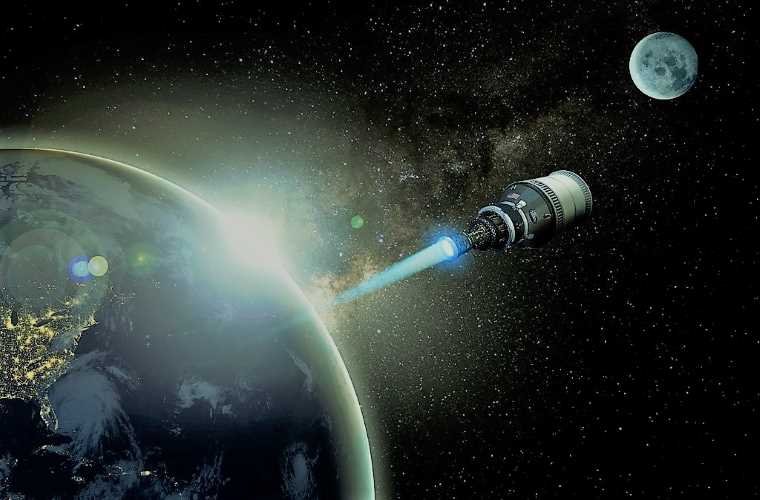The Defense Advanced Research Projects Agency (DARPA) and NASA are tasking Lockheed Martin with helping them build a nuclear propulsion rocket capable of taking humans to Mars for future missions.
The Wednesday announcement revealed that the aerospace giant’s Littleton, Colorado location will lead the effort as the prime contractor involved in developing and testing a nuclear-powered rocket demonstration with help from several other industry partners.
The effort, formally known as the Demonstration Rocket for Agile Cislunar Operations (DRACO) program, originally planned demonstrations of a nuclear thermal propulsion (NTP) system above low Earth orbit by as soon as 2025, although that timeline has now been extended to 2027.
NASA Deputy Administrator Pam Melroy said on Wednesday that the space agency’s collaboration with DARPA and commercial industry leaders like Lockheed Martin “will enable us to accelerate the technology development we need to send humans to Mars.”
“This demonstration will be a crucial step in meeting our Moon to Mars objectives for crew transportation into deep space,” Melroy said.
In recent years, nuclear propulsion has remained a prime objective for NASA in terms of making crewed missions to Mars a reality.
The DRACO program aims to develop nuclear propulsion capabilities with high thrust-to-weight ratios that are comparable to traditional rocket fuel-based approaches, with the additional capability of enabling high-efficiency propulsion aided by electric systems.
Dr. Tabitha Dodson, DARPA program manager for part of the DRACO effort, said the program aspires to provide the United States with what she called “leap-ahead propulsion capability.”
“An NTR achieves high thrust similar to in-space chemical propulsion, but is two-to-three-times more efficient,” Dodson said in a statement.
“With a successful demonstration, we could significantly advance humanity’s means for going faster and farther in space and pave the way for the future deployment for all fission-based nuclear space technologies.”
In the past, electric propulsion technologies have been incapable of achieving the thrust-to-weight efficiency required for space travel, whereas chemical rockets are encumbered by issues related to propellent efficiency.
With nuclear propulsion, astronauts would benefit from a shorter, safer journey to Mars, helping to improve the overall mission efficiency by requiring far less propellant, and thereby freeing up space for food and other equipment needed for long-duration space exploration, as well as scientific instrumentation.
Another benefit of nuclear power systems is that in addition to powering a next-generation rocket for space travel, it can also be used to power technologies used for communication, as well as scientific research.
Dr. Prasun Desai, acting associate administrator for STMD at NASA Headquarters in Washington, said on Wednesday that NASA’s past developmental investments with the U.S. Department of Energy (DOE) have significantly helped to enable the growth of nuclear propulsion technology and relevant capabilities in the commercial sector.
“Now, those investments are coming full circle as we work with these same companies to build the first nuclear-powered rocket to fly in space,” Desai added.
According to NASA’s statement this week, the space agency plans to put close to $300 million into the DRACO program, more than two-thirds of which will go toward the design and development of a nuclear propulsion engine. Lockheed Martin will be tasked with the design and testing of the spacecraft.
In addition to NASA and DARPA’s partnership with Lockheed Martin, commercial partners that include Virginia-based BWX Technologies will aid in the design and construction of the nuclear fission reactor used to power the DRACO engine, with management and other priorities overseen by NASA’s Space Technology Mission Directorate (STMD).
In coordination with National Security Presidential Memorandum 20 (NSPM-20), a measure that provided updates to existing U.S. policy related to the launch of nuclear propulsion and other nuclear power systems into space,
DARPA will be behind the use of high-assay low-enriched uranium (HALEU) fuel for the DRACO program, in addition to the agency’s responsibilities for engineering an innovative system that will allow the rocket engine’s fission reactor to remain offline until reaching its target orbit.
It was also announced this week that the U.S. Space Force will provide the launch site for the DRACO program, along with additional on-site support.
Micah Hanks is the Editor-in-Chief and Co-Founder of The Debrief. He can be reached by email at micah@thedebrief.org. Follow his work at micahhanks.com and on Twitter: @MicahHanks.

